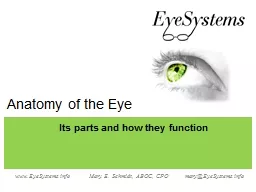

wwwEyeSystemsinfo Mary E Schmidt ABOC CPO maryEyeSystemsinfo Anatomy of the Eye Anatomy The Protective Fibrous Tunic Sclera Limbus The Protective Fibrous Tunic ID: 912950
Download Presentation The PPT/PDF document "Its parts and how they function" is the property of its rightful owner. Permission is granted to download and print the materials on this web site for personal, non-commercial use only, and to display it on your personal computer provided you do not modify the materials and that you retain all copyright notices contained in the materials. By downloading content from our website, you accept the terms of this agreement.
Slide1
Its parts and how they function
www.EyeSystems.info
Mary E. Schmidt, ABOC, CPO mary@EyeSystems.info
Anatomy of the Eye
Slide2Anatomy
Slide3The Protective – Fibrous Tunic
Sclera
- Limbus -
Slide4The Protective – Fibrous Tunic
CORNEA:
Slide5Anterior Chamber and Aqueous
Slide6Nourishing Tunic or Vascular or Uveal Tunic
Pupil – opening in the iris.
Iris – pigmented muscle.
Slide7Nourishing Tunic or Vascular or Uveal Tunic
Three pupillary responses:Direct – Consensual –
Bilateral –
Slide8Nourishing Tunic or Vascular or Uveal Tunic
Ciliary body, ciliary muscle –
Choroid –
Slide9Nourishing Tunic or Vascular or Uveal Tunic
CRYSTALLINE LENS
Slide10Nourishing Tunic or Vascular or Uveal Tunic
Vitreous –
Slide11Light Sensitive - Inner Tunic
Retina, rods and cones – It CANNOT regenerate.
Slide12Light Sensitive - Inner Tunic
Cones – give color vision – function in daylight. Packed into the fovea. About 6 million cones per retina. Provides “photopic” vision, vision in bright light.
Rods – function under low light & gives shades of grey. About 120 million rods per retina. Provides “scotopic” vision, vision in dim light.
Slide13Light Sensitive - Inner Tunic
Macula – cones are concentrated here, no rods.
Devoid of blood vessels. Macular degeneration.Fovea – center depressed area of the macula. It gives best visual detail – packed with cones. Size of a pinhead!
Slide14Light Sensitive - Inner Tunic
Optic nerve – a direct extension of the retina. Feeds messages to the brain. It is located about 3.5 mm nasal to the macula. No vision in this area, so projects as a blind spot. This is the area affected by glaucoma.
Visual Pathway – as the retinal fibers leave the optic nerves, half of them cross to the other side at the optic chiasm.
Slide15Light Sensitive - Inner Tunic
Slide16Light Sensitive, Inner TunicExtra-ocular muscles – 6 rotate the globe is all possible directions. All muscles cooperate in each movement. Some contract while others relax. Likewise the muscles of both eyes cooperate, so that neither eye moves alone.
Slide17VISUAL FUNCTION
Emmetropia
– measurement of the normal eye.
Slide18VISUAL FUNCTION
Hyperopia
– light rays focus behind the retina. Ammetropia – measurement of an abnormal eye.
Slide19VISUAL FUNCTION
Myopia – light rays focus in front of the retina.
Ammetropia – measurement of an abnormal eye.
Slide20VISUAL FUNCTION
Astigmatism – light rays do not come to a point on the retina. Can be corneal or lenticular astigmatism.
Ammetropia – measurement of an abnormal eye.
Slide21VISUAL FUNCTIONPresbyopia – can no longer see clearly up close. Ability to accommodate for near vision decreases due to loss of elasticity of the crystalline lens and weakness of the ciliary muscle.